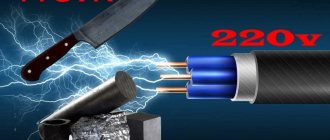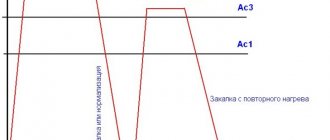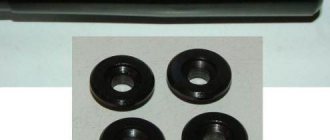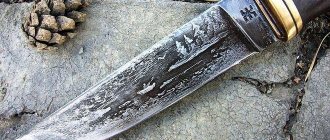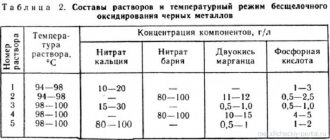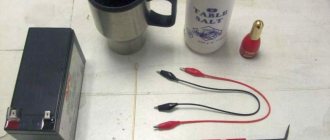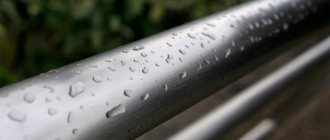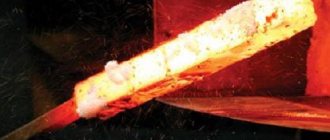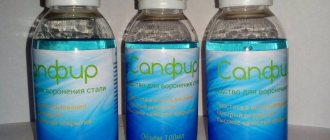It is no coincidence that the question of how to harden a knife yourself at home is so relevant, because it is this technological operation that allows you to give the blade of a cutting tool the required strength and hardness. If you neglect this procedure or perform it incorrectly, the cutting part of your knife will quickly become dull, which will make its use ineffective.
The durability and cutting ability of a knife are determined by the hardness of the blade.
Even if a homemade knife is made of a solid metal product (file, spring, valve, etc.), it still requires hardening, since during the manufacturing process the blade was subjected to intense mechanical processing and, accordingly, heating. It is quite simple to check how correctly the hardening of a homemade knife has been carried out at home. To do this, you need to hold its blade in a vice and begin to bend it vertically. If the knife breaks at a bend angle greater than 45°, it means the hardening was done correctly.
For those who do not like to go into the subtleties and details of the process, you can immediately watch a video with a detailed description and demonstration of one of the methods of hardening a knife at home. If you want to get acquainted with the technology in more detail, we recommend reading the entire article.
Hardening defects
Hardening defects include:
- cracks,
- leashes or warping,
- decarbonization.
The main reason for cracks and cracks is an uneven change in the volume of the part when heated and, especially, during sudden cooling. Another reason is the increase in volume during martensite quenching.
Cracks arise because stresses due to uneven changes in volume in individual places of the part exceed the strength of the metal in these places.
The best way to reduce stress is to cool slowly around the martensitic transformation temperature. When designing parts, it is necessary to take into account that the presence of sharp corners and sudden changes in cross-section increases internal stress during hardening.
Warping (or warping) also arises from stress as a result of uneven cooling and manifests itself in the curvature of parts. If these distortions are small, they can be corrected, for example, by grinding. Cracks and warping can be prevented by preliminary annealing of parts, uniform and gradual heating of them, as well as the use of stepwise and isothermal hardening.
Decarburization of steel from the surface is the result of carbon burnout during high and prolonged heating of the part in an oxidizing environment. To prevent decarburization, parts are heated in a reducing or neutral environment (reducing flame, muffle furnaces, heating in liquid media).
The formation of scale on the surface of the product leads to waste of the metal and deformation. This reduces thermal conductivity and, therefore, reduces the rate of heating of the product in the furnace and complicates mechanical processing. Scale is removed either mechanically or chemically (etching).
Carbon burned from the surface of the metal makes the product decarbonized with reduced strength characteristics and difficult machining. The intensity with which oxidation and decarburization occurs depends on the heating temperature, i.e., the greater the heating, the faster the processes occur.
The formation of scale during heating can be avoided if a paste is used for hardening, consisting of liquid glass - 100 g, refractory clay - 75 g, graphite - 25 g, borax - 14 g, carborundum - 30 g, water - 100 g. The paste is applied to the product and allow it to dry, then heat the product in the usual way. After hardening, it is washed in a hot soda solution. To prevent the formation of scale on high-speed steel tools, a borax coating is used. To do this, the instrument heated to 850°C is immersed in a saturated aqueous solution or borax powder.
How to carry out the procedure yourself
To do this, you do not need to have any experience - just follow the instructions exactly, which will tell you how to harden knives at home on your own. The procedure can be used for any type of blade - an ax, scissors, and other cutting tools.
Heating source
In the open air, part of the heat emanating from the fire evaporates - the resulting temperature, especially when heat treating high-carbon steel, may not be enough. In these cases, it is better to use a muffle furnace, cutter, blowtorch, forge, even a regular electric or gas stove. When making a batch of knives, it is better to determine the hardening time experimentally using a test. To do this, several metal plates are heated: one to the maximum, the other a little less.
The fuel is coals, which are heated to a maximum white color. The shade of the flame is yellow-orange or crimson. The fire should be distributed evenly over the entire area of the fire. After heat treatment, the hot object is dipped into the oil three times for a few seconds. The last stage is immersion in a container of water. The liquid should be thoroughly mixed (shaken) beforehand.
Blowtorch
Bake
Horn
Gas stove
Temperature
There are several methods for hardening steel with different heating temperatures, holding times and cooling rates. Each grade of metal requires a certain temperature regime:
- for knives made of low-carbon steel, the temperature range should be 757-950 ° C;
- blades made from high-carbon grades are hardened at 680-850 °C;
- alloying alloys will require heating to 850-1150 °C.
In production conditions, to determine the degree of heating, a non-contact measuring device is used - a pyrometer; in everyday life, an ordinary magnet is used. With a significant increase in temperature, the magnetic properties of the metal decrease: if the steel workpiece is not attracted to it, the temperature is optimal.
Experienced craftsmen are able to determine the quality of hardening by the color of the steel: the lighter it is, the stronger the heating. The metal should not be overheated, otherwise it will turn black and it will be impossible to clean it. The sharpened part of the blade is heated 3 times to an almost purple color, that is, to a temperature of 285 ° C. The cutting part is processed on fire only once, but heated more strongly, until a yellow-orange tint appears, that is, up to 950-1000 ° C.
Red color indicates heating to 720-950 °C. Raspberry or light cherry shades of steel mean that the heating temperature corresponds to 800-850 °C. The appearance of a burgundy color in the flame indicates that the blade is not heated enough, only to 650-720 °C, brown - the temperature is not higher than 530-580 °C.
Cooling and holiday
Depending on the heat treatment method and the type of blades, different cooling methods are used, for example, in mineral oil (waste oil) or ordinary water with added salt. Options:
- if the blades to be hardened are heated red-hot, they are cooled in oil, dipping into it three times, so that each subsequent cooling is longer than the previous one; the last stage is immersion in pre-mixed water;
- for knives with double-sided blades, to give them greater sharpness and elasticity, the blades, on the contrary, are first dipped in water for a couple of seconds and then used for sharpening;
- To make the middle of the blade as elastic as possible, you can first warm it up with a metal rod, then immerse the knife in boiling water for a couple of hours, then in ice water.
It should be taken into account that metal cools 2 times faster in oil (working oil). To determine the cooling rate of a material in different solutions, you can refer to the summary table.
| Environment used | Cooling rate, °C |
| Water heated to 27 °C | 450 |
| Room temperature oil | 150 |
| Ice water | 600 |
| Machine oil heated to 20 °C | 150 |
Steel that has been quenched and cooled is still too brittle. To further increase the characteristics of plasticity and viscosity, it should be heated again for an hour, but only to 150-200 ° C (this procedure is called tempering). For alloyed metal, the temperature should be in the range of 270-320 °C, for high-speed metal – even higher. To prevent the blade from bending during rapid cooling, it must be lowered into the liquid strictly vertically, the cutting edge must be at the bottom, and the blade must remain motionless.
Cooling in oil Vacation
Heat treatment: how best to harden iron at home
This is a heating process followed by further cooling to change properties. We place a regular alloy in the furnace, and take out a hardened one, which is less susceptible to external deformations. What is it for? During primary processing, for example during stamping, cutting or casting, internal stresses appear inside the alloy, which have a very negative effect on the strength characteristics and increase brittleness. There are four types of heat treatment:
- Annealing. Necessary for the formation of ferrite and pearlite. It consists of heating in a furnace to 680-740 degrees, when the recrystallization threshold has already passed. As a result, old molecular bonds break down and new ones form. Then follows some exposure at a temperature of 400-500, at the end - cooling, slow, together with the heating element and simply open doors.
- Normalization is similar to the procedure for relieving internal stress, but heating is higher and cooling is much faster.
- Hardening. The main process that occurs is a change in grain size, which leads to the desired results. Cooling is very rapid, often in water or oil.
- Vacation. It comes in several modes. Let's talk about it separately.
Requirements for the hardening chamber
The main thing in the forge is the choice of bricks from the right material. They must be made of fireproof clay. This is the key to long-term operation of the entire structure. If you plan to harden long knives, you can make a forge of one and a half or two bricks.
When choosing a propane burner, you should pay attention to the presence of a control valve. This will allow you to select the optimal temperature regime based on the size and type of knife
The hole for the heating chamber can be made with a regular drill. Refractory materials are not very hard, so this procedure does not take much time. In addition, it is necessary to make a side hole for the burner flame. It should be remembered that the nozzle should be located at a distance of 2-3 cm from the edge of the brick.
With this design, you can quickly and conveniently heat small knives. Alternative heat sources will be discussed below.
Properties of metal after processing
After carburization, the hardness of the carburized layer reaches: 58-61 HRC on alloy steels and 60-64 HRC on low-carbon steels. Prolonged exposure of steel to high temperatures causes a change in the structure of the metal.
Steel structure after carburization
To correct large grains of metal, parts after carburization are subjected to reheating and hardening, followed by tempering or normalization.
Hardening is carried out at a temperature not exceeding 900C. In the metal, grain refinement occurs due to the production of pearlite and ferrite.
Instead of hardening, alloy steels are subject to normalization. After through heating, martensite forms in the middle of the part. The heating of the part depends on the grade of steel from which it was made.
Heat treatment modes for steel after carburization
The final phase is low-temperature tempering, which eliminates surface stresses and deformations caused by high-temperature treatment.
Steel cementation at home: what it is and how to do it
The carburization process is based on the principle of chemical and thermal treatment of metal. The whole point of the procedure is to saturate the steel surface with the required amount of carbon under certain temperature conditions.
Several years ago, this procedure was almost impossible to implement at home. Today this is possible using graphite media or their analogues. The main thing is desire and some knowledge.
The first step is to understand the basics of heat treating steel.
The features of metal carburization include the following factors:
Thanks to the procedure, case-hardened steels become stronger, which increases the wear resistance and strength of the material; The operating properties of the metal are changed by heating the products in a liquid, gas or solid medium, which improves its characteristics; Parts can be heated to different temperatures; there is no limited constant or exact recommendations. At home, the cementation process takes place at a temperature of 500 degrees Celsius. In industrial conditions using professional equipment, the heating temperature in the furnace reaches more than 1300 degrees Celsius. You should know that the temperature is chosen taking into account the concentration of impurities and carbon. Professionals recommend cementing low-carbon types of steel (approximately 0.2%) at home. For example, a blade from an inexpensive kitchen knife made of steel or small parts. Carbon penetrates into the structure of steel rather slowly. Therefore, cementation of the knife blade in a home procedure occurs at a rate of no more than 0.1 ml per hour. In order for the same blade to withstand heavier loads, it is necessary to strengthen the layer with a thickness of up to 0.8 ml per hour
It is also important to understand that carburizing a knife or small shaft in a home workshop will take at least eight hours. In this case, you should maintain a certain temperature in the oven so as not to disturb the temperature regime. During the process of carburization, not only the property of the metal changes, but also its phase composition and atomic lattice
In general, the surface obtains the same characteristics as when hardened, but it is possible to control it over a narrow temperature range in order to avoid various material defects.
Carburizing stainless steel is a little more difficult, but at the same time it will qualitatively improve the characteristics of this type of metal.
Case hardened steels using gas
For the first time, steel cementation with gas was carried out at the Zlatousovsky plant under the vigilant leadership of P. Anosov. This effective method was developed by V. Prosvirin, S. Ilyinsky and N. Minkevich.
The essence of the process is quite simple - the metal is cemented under the influence of carbon-containing gas (natural, artificial or generator) in a hermetically sealed furnace.
The most accessible and frequently used gas is a composition obtained from the decomposition of petroleum products.
It is made in the following way:
- Kerosene is poured into a special steel container and heated until the process of pyrolysis occurs - the decomposition of kerosene into a mixture of several gases;
- approximately 60% of this gas is modified and made suitable for cementation.
A mixture of modified gas and pure pyrolysis gas is used for cementation. The need to modify part of the gas is due to the fact that the use of pure pyrolysis gas on steel results in insufficient carburization, and a little soot may settle on some parts, which is difficult to remove.
The process of carburizing steel with gas is carried out in special continuous conveyor furnaces. Or they use unique stationary units.
First, the part is placed in the furnace, its muffle. The installation is closed and the furnace is heated to 950 degrees. Then pre-prepared gas is supplied.
It is almost impossible to carry out this procedure at home.
At the same time, it has several advantages over the solid processing method:
- less time is spent on preparing raw materials for cementation;
- more favorable and safe working conditions for workers;
- acceleration of the hardening process by reducing the holding time of products.
The most important thing when carburizing steel is a well-organized process and high-quality equipment and raw materials. The solid method can be implemented at home if you have a stove, carburizer and metal molds
As well as certain skills and abilities associated with this steel hardening process.
The use of spring steel for making a knife
How to make a knife with your own hands at home
Spring material 65G is used by amateur knife makers to make knives. Thanks to its unique characteristics, the metal finds its application in various fields.
Spring steel.
Blades for the kitchen, hunting, tourism - all show excellent cutting qualities. If there is a special need, you can actually forge a sword or an ax. After hardening, the steel acquires good rigidity, which allows the product to be cut. Examples of using spring steel:
- Kitchen knife. In difficult times for the country, after the collapse of the USSR, not all people could afford a good set of kitchen knives. I had to get out. Springs and plates made of 65G steel were easily accessible. In the kitchens of the post-Soviet space, homemade products were often found. The handle was made from improvised material: wood, simple epoxy, and electrical tape - which did not prevent the knives from remaining at their height.
- Tourist knife. The disadvantage of spring metal is that it is susceptible to corrosion and requires constant care after use. The knife is suitable for use in hiking conditions. An important point is hardening. If it is weak, the blade will quickly become dull on the tin can. You should know the hardness of the knife.
- Army. Tactical or, nowadays, military knives do their job well. Serrated sharpening will increase the scope of use of the blade. Withstands piercing blows without problems. In everyday conditions it will become a valuable assistant for a fighter or a “survivalist”.
- Axe, machete or sword. Alloy 65G and analogs allow you to make truly formidable weapons. The thickness of the product certainly plays a significant role. When producing such a masterpiece, you need to stock up on springs from a truck, or get a long plate.
With proper processing of the metal, we are guaranteed to get an excellent blade. Little experience with the manufacture of steel products, nonsense. Further, in the article we will provide a detailed description of the manufacture of knives from springs using various methods.
Structural changes in metal
When nitrogen and carbon atoms are introduced into the surface layer of the metal, some changes occur. During nitrocyanation, the ratio of the residual amount of austenites and fine-crystalline martensites in the surface layer changes, a small amount of a solid solution of carbonitrides is added, which affects the mechanical properties - hardness and wear resistance.
At the same time, fragility increases slightly and fatigue and contact strength decreases. This quality is especially evident in alloy steel with a nickel content of more than 1.2%. Thus, not all brands can be processed using this method. Reducing the grain size of the structure is achieved by additional hardening and tempering immediately after the nitrocarburization process. Steel treated in this way has a smaller grain size than cemented steel, which increases its bending strength while reducing the thickness of the treated layer.
Nitrocarburization significantly changes the characteristics of the thin outer layer of metal, its hardness and wear resistance. After additional heat treatment - hardening, the hardness of the surface layer on the Rockwell scale is 58-64 HRC or 500 - 1000 HV according to the Vickers method. Using low-temperature carburization, it is possible to obtain a thin surface layer with a hardness of 5000 – 11000 HV.
Technology, equipment, methods of monitoring and regulating the atmosphere.
General information.
Cementation of steels and alloys is the most common type of chemical-thermal treatment of steel in mechanical engineering. Cementation is the adsorption of carbon atoms by the surface of a material and their further diffusion movement into the depths of the metal in order to enrich the surface layer with carbon. The required hardening of the surface layer of the product is achieved by the formation of carbides during sudden cooling.
Hardening should not only strengthen the surface layer, but also correct the overheating structure that occurs due to the workpieces being held for many hours at high temperatures. Cementation is carried out when it is necessary to give the surface layers of parts increased hardness, wear resistance and strength, with a relatively plastic core. The final operation of heat treatment of cemented products in all cases is low tempering at 160–180 ºС, transforming hardened martensite in the surface layer into tempered martensite, with lower stresses.
Main features and advantages of the steel carburization process.
- High hardness and wear resistance of cemented surfaces.
- Increasing the limit of contact stability.
- Increasing the limit of contact stability. .
- It is the most common hardening method. .
- Increasing the endurance limit in bending and torsion. .
The best results can be achieved if alloy steels with low carbon content are cemented. Thus, the hardened part remains plastic and can simultaneously work on contact wear, resist impact loads and have sufficient toughness and bending strength, which cannot be achieved with volumetric hardening of high-carbon steels due to insufficient impact toughness. For example:
gear teeth and cams work simultaneously for contact wear and bending. The maximum hardness of the outer surface and, accordingly, high wear resistance of the part is acquired when the carbon concentration on the surface reaches the range of 0.8-1.2% carbon. This is the value they try to achieve during cementation.
The depth of the leveled layer is set based on the thickness of the workpiece and its structural purpose.
Through cementation of the workpiece should not be allowed. The soft core must remain to absorb stress during bending or torsion. To predict the required thicknesses of cemented layers on finished parts, it is necessary
take into account the allowance for machining if the part will work in conjunction with other parts.
The part receives its final hard surface after hardening, similar to the hardening of high-carbon steels. There are situations where a hard surface is not necessary on all surfaces. In this case, after carburization, slow cooling is carried out, followed by mechanical treatment of surfaces where there should not be a hard surface. After removing the high-carbon layer, repeated heating for hardening is carried out, followed by low tempering.
Liquid cementation
Liquid cementation is performed in molten salts, usually salts consisting of alkali metal carbonates. This mixture is melted in a bath and carburization is carried out by immersing the parts in the melt. The process is carried out at 850°C for 0.5 - 3.0 hours, while the milking depth is within 0.2 - 0.5 mm. The main advantage of the process is the possibility of direct hardening from a carburization bath and small deformations of the processed products. In conditions of individual and small-scale production, cementation from pastes has found some application. In this case, a coating containing soot (33–70%), wood dust (20–60%), yellow blood salt (5–20%) and other components is applied to the treated surface. Organic, organomineral and inorganic adhesives are used as binding materials. The thickness of the coating should be 6–8 times greater than the required thickness of the cemented layer.
Currently, the most promising cementation method is carburization in an endothermic atmosphere with controlled carbon potential. During gas cementation in an endothermic atmosphere, at the beginning of the process (during the active period of saturation), a high carbon potential of the atmosphere is maintained by adding unprocessed hydrocarbon gas (methane or propane-butane) to the endothermic atmosphere. During the diffusion period, the carbon potential of the atmosphere is set to 0.8 - 1.0% and the amount of added hydrocarbon gas decreases sharply.
Shaping the blade and handle of the blade
The cooled workpiece is fixed in a vice and the excess parts are cut off, giving a shape according to the patterns prepared in accordance with the drawing. The precision of removing excess metal with a hacksaw will reduce the duration of sharpening the product with a file. When cutting out the shank, you need to take into account that its size must correspond to the length of the fingers. Processing with an abrasive disc attached to an electric sharpener will help give the knife the intended shape.
When turning slopes, the workpiece is secured to the workbench with clamps. When performing this operation, it is necessary to control the symmetry of the processing of both sides of the product, removing layers of metal at one angle throughout the descent. Holes drilled on the handle of the blade will allow you to attach the handle plates using rivets. When the future knife takes on the intended shape, begin finishing the surface with sandpaper secured to the block. The softness of the annealed metal makes it easier to form a blade, but to get a good knife, the steel must be hardened and tempered.
https://youtube.com/watch?v=-rWxWfg12Uc
Nitriding of steel
When nitriding, the surface layer of a steel part is saturated with oxygen. This method received industrial application almost 100 years ago, in the 20s of the 20th century. Nitriding a part is an excellent way to increase not only the hardness of the product, but also its corrosion resistance.
Nitriding of steel is carried out by immersing the part in furnaces, which are hermetically sealed. Ammonia is supplied there, which, when heated, breaks down into nitrogen and hydrogen. During this reaction, nitrogen atoms are absorbed by the steel surface layer and penetrate into the part.
It is difficult to say how deep and durable the layer subject to nitriding will be. This factor depends on many details:
- temperature at which nitriding was carried out;
- duration of part processing;
- composition of steel that has been nitrided.
Chemical-thermal treatment method
The described procedure does not allow achieving several goals simultaneously, unlike cementation. There are two types of nitriding.
Increasing the strength of the surface layer of a steel part. The process temperature is up to 560 °C, the average layer thickness is 0.5 mm. The duration of the operation can reach one day.
Increased corrosion resistance. The optimal temperature is from 650 to 700 °C. Anti-corrosion nitriding can continue for up to 10 hours. The thickness of the layer formed in the process is 0.3 mm.
The steel nitriding process can only be carried out on fully finished products that have gone through the stages of heat and mechanical treatment. The structure of sorbitol inside the product is completely preserved, which increases the strength and toughness of the part.
Gas cementation
In mechanical engineering, the technology of saturating the top layer of steel products with carbon in an atmosphere of carbon-containing gases is widespread. It is known that such production is convenient for mass processing of parts, since:
- Adjustment of gas density is allowed; thereby forming a carbon layer with the desired properties.
- The full heat treatment cycle (cementation, hardening, washing and tempering) takes place in one place - in a shaft (cementation) furnace.
- The process is economical, mechanized and automated.
- Boxes with a carburizer do not require heating, which reduces the time of carburization.
- The rate of carburization of parts increases by 2–3 times (compared with other methods), and the uniformity of the layer is higher.
- The temperature of the gas mixture of hydrocarbons (methane and carbon monoxide) is adjusted to 900-950°C.
- After carburization, the technological chain is completed by tempering (hardening).
Hardening the cutting edge of a knife
We take a knife.
We go along the edge with a file, while paying attention to the dull sound and slight grinding of the metal. Everything indicates that the knife is made of ordinary steel and has not been previously hardened
For hardening you need graphite. It is best to obtain graphite from graphite brushes of a generator or brushed electric motor. Of course, I haven’t tried it, but you can also get graphite rods from AA batteries or simple pencils. In general, we grind this graphite into powder in any way. There is no need to grind it too much, without fanaticism.
Next, I need a metal base on which the graphite powder will lie. I took a piece of galvanized drywall profile.
The knife edge hardening process also requires a power source. Ideally, this is a pulsed DC welding machine set to minimum. You can also try to repeat the process using another source, 30-60 volts AC or DC. There is another dangerous option: using a 220 V network directly, in series with an incandescent lamp, but this is already fraught, so I do not recommend it.
Pour in graphite. We connect the plus of the welding machine to the base of the substrate, and the minus to the knife. We set the inverter to minimum settings and turn it on. We begin the process of hardening the edge. To do this, very carefully run the edge of the knife along the graphite pile. Our task is: first, to prevent the blade from touching the base. And the second thing is to prevent the graphite from burning. In both cases the blade will be damaged.
Ideally, the blade should be moved slowly, and the graphite should sparkle and flicker. Naturally, you don’t need to lower the knife too much. As soon as you notice the contact area heating up, immediately lift the knife.
The whole process does not last long, about 5 minutes. During this time I managed to walk along the entire length of the blade several times.
DIY file knife
You can’t do your work without:
- A good, large, Soviet-made file.
- Hacksaws for metal (several spare blades).
- Working file with a comfortable handle.
- Sandpaper and block.
- Workbench and vice.
- Clamps (2 pcs.).
- Wood (kebab) charcoal for the forge.
- Processing (of old motor oil) for hardening.
Good products are obtained from files with ground teeth - in this case, you do not have to waste time removing them.
At the initial stage, the metal is annealed. But before this, you should make a “camping” forge: pour a hearth of earth, insert a two-inch pipe (to allow air to flow in) and light the coal. When the steel turns red, stop supplying air and leave the workpiece to cool slowly. The metal will be pliable and can be easily processed.
All excess is cut off with a hacksaw according to pre-prepared patterns. Try to repeat the future shape as accurately as possible in order to use less file work. Cut a shank as long as your fingers.
Then process the workpiece using a file or emery, shaping it according to the pattern. Press the future knife against the workbench and use a clamp to sharpen the slopes. This part of the work is responsible and should not be done by eye. The two sides should be symmetrical, the metal removal angle should be the same along the entire length of the trigger, including the bend of the tip. For convenience, you can build an auxiliary device in the form of a metal pipe with a guide, and attach a long file to it.
Since the workpiece is annealed, it does not require much effort to process it. After the rough shaping is completed, the final finishing is done with sandpaper. For maximum effectiveness, it can be wound on a small wooden block.
The blade is ready, but the softness of the annealed steel will not allow you to use it to your fullest, so hardening will be required.
Hardening procedure
During this procedure, the structure of the metal changes, it becomes hard and slightly brittle. Quenching is carried out in processing oil. The finished product should be heated until it acquires a dark cherry hue.
When the weather is sunny outside and it is difficult to determine the temperature by color, readiness can be checked using a magnet: if the steel is well heated, it will not be magnetized. Then quickly lower the blade into the container with oil. To cool it faster, place a bowl of cold water under the container - this way you can achieve a more effective result.
Glassware will help check the hardness: if it is well tempered, grooves will remain on it. The main disadvantage is the labor-intensive manufacturing process. Another feature is that a file cannot be used to make a thin and flexible blade.
Among the indisputable advantages are the strength and durability of such products. The material for manufacturing is freely available, practically free, with a butt thickness of 6 mm, which does not allow knives made from files to be classified as edged weapons.
General information about the process
The first step is to understand the basics of heat treating steel.
The features of metal carburization include the following factors:
Thanks to the procedure, case-hardened steels become stronger, which increases the wear resistance and strength of the material; The operating properties of the metal are changed by heating the products in a liquid, gas or solid medium, which improves its characteristics; Parts can be heated to different temperatures; there is no limited constant or exact recommendations. At home, the cementation process takes place at a temperature of 500 degrees Celsius. In industrial conditions using professional equipment, the heating temperature in the furnace reaches more than 1300 degrees Celsius. You should know that the temperature is chosen taking into account the concentration of impurities and carbon. Professionals recommend cementing low-carbon types of steel (approximately 0.2%) at home. For example, a blade from an inexpensive kitchen knife made of steel or small parts. Carbon penetrates into the structure of steel rather slowly. Therefore, cementation of the knife blade in a home procedure occurs at a rate of no more than 0.1 ml per hour. In order for the same blade to withstand heavier loads, it is necessary to strengthen the layer with a thickness of up to 0.8 ml per hour
It is also important to understand that carburizing a knife or small shaft in a home workshop will take at least eight hours. In this case, you should maintain a certain temperature in the oven so as not to disturb the temperature regime. During the process of carburization, not only the property of the metal changes, but also its phase composition and atomic lattice
In general, the surface obtains the same characteristics as when hardened, but it is possible to control it over a narrow temperature range in order to avoid various material defects.
Carburizing stainless steel is a little more difficult, but at the same time it will qualitatively improve the characteristics of this type of metal.
The essence and purpose of the cementation process
Metal cementation is one of the types of chemical-thermal surface treatment along with nitriding, cyanidation and aluminizing. The essence and its purpose are the diffusion saturation of the surface of the workpiece with carbon atoms. As a result, the following characteristics are increased:
- hardness;
- strength;
- resistance to mechanical stress.
High temperature is necessary to activate carbon, which plays a key role in cementation. In this case, it easily penetrates into the intercrystalline space of the steel and is absorbed there.
The technology is characterized by a low rate of interaction between steel and carbon. It takes an average of one hour to obtain a layer 0.1 mm thick. It is noteworthy that the process has a direct relationship: the depth of cementation does not affect the processing time.
Uniform heating
Using this technique will require repeated use of coolant, so you need not one container, but several. The whole process is based on uniform heating of the workpiece in the furnace. If you periodically dip a part into oil, it will heat up over time, so you will have to change the container. After completely heating to the required temperature, you need to suddenly place the product in the oil to cool it as quickly as possible.
It was repeatedly noticed that during the heating process, the hardened workpiece noticeably changes color; temperatures were measured during the process, which led to certain conclusions. The longer the workpiece is heated, the higher its temperature, and in the color scheme this was expressed as the acquisition of a lighter shade. At the moment when the metal had a red-brown color, the temperature of the workpiece was approximately 530-580 degrees, then its shade turned into burgundy, and the temperature readings were 650-720 degrees. Over time, the burgundy turned into red; measurements already show results of 720-950 degrees. And only after the 950 mark did the metal begin to acquire a bright orange hue.
These measurements help to extract another trick that will undoubtedly help the home craftsman during hardening, especially if he has not had such experience before.
It is also worth noting that when using steel containing chromium, the heating temperature changes more slowly. Therefore, to achieve the same results, you will have to spend a little more effort and time.
Home hardening and its tricks
Making a knife from a file with your own hands at home
High-quality hardening can be successfully performed at home, you just need to have the right approach to such a fascinating process and your tool - a folding or hunting knife, a homemade file or a butterfly knife. The problem will become a little more serious if your product is made of stainless steel, but even in this case there is a solution, you just need to get acquainted with the nuances of the procedure and prepare the necessary equipment for heating.
A couple of paragraphs about cooling media
Such a cooling medium can be various substances. The most popular, due to their availability, are oil and water. Therefore, check out the cooling rates of steel products:
- Water. If its temperature slightly exceeds 20°, then the cooling rate will be 450°/s. When it is icy, the value is higher - 600°/s.
- Oil. Its room temperature allows you to cool the blade at a rate of 150°, but if it is heated to 200°, this value will double.
Graphite hardening
Hardening in graphite is excellent for hardening the cutting edge of a knife with a fairly thick blade. This technology allows for high-quality processing of a variety of models, and carrying out this procedure at home is not difficult. You can get acquainted with the process, but it is better to do this by watching the video.
Sending the knife on zone vacation
It is also possible to zone harden the knife if you are satisfied with the blades, but you want the middle part to become more elastic. Then the processing algorithm is as follows:
- Take a rod with a diameter of 10 mm. It is heated “to white heat”, after which it is applied to the middle part of the knife.
- After this part has thoroughly warmed up, the blade is placed in boiling water, in which it is left for 2 hours.
- When the exposure time comes to an end, the knife should be immersed in ice water.
This operation is called low release. What needs to be taken into account for a high-quality result:
- A small volume of liquid will not be able to provide the desired result: the liquid will quickly heat up, and because of this, both a change in the required cooling rate and a violation of the temperature regime will occur. The minimum amount of water in this case is 20 liters.
- The position of the blade in the cooling environment must be fixed, otherwise problems will arise with the uniformity of heat transfer, which will lead to disappointing consequences for the knife.
Cyanidation of steel
This process is somewhat different from carburization and consists in the fact that the surface layer of the steel element is saturated not only with carbon, but also with nitrogen. In industry, high- and low-temperature cyanidation is used, while carburization does not allow several types of operations.
High temperature cyanidation
The main objective of this process is to make the part harder and more wear-resistant. The manipulation is carried out in baths that are filled with neutral salts: BaCl2, NaCl, Na2CO3 and some others. The role of carburizers is performed by KCN and NaCN salts, the active ingredient of which is cyanogen. It contributes to the fact that the steel part is saturated with nitrogen and carbon. The process is carried out at temperatures up to 900 °C.
In order for the cyanidated layer to become as durable as possible, the parts are hardened either in oil or in water for one and a half hours. To prevent the amount of cyanide from decreasing (it gradually burns out), small portions of cyanide salts are added to the bath.
Low temperature cyanidation
This process is appropriate if the part must meet the criteria of increased strength and wear resistance. The temperature required to achieve these goals ranges from 550 to 570 °C (high-speed steel) and 510–520 °C (high-chromium steel).
The procedure is carried out in a salt bath, the contents of which are equal parts of NaCN and KCN. The depth of the resulting layer is from 0.01 mm (with a cyanidation duration of 10 minutes) to 0.06 mm (with a process duration of up to 60 minutes).
Gas Application
In mass production, a gaseous environment is used. Surface saturation with carbon can only be carried out using a sealed oven. The most common composition of the gas environment is the substances obtained from the decomposition of petroleum products.
Gas carburization of steel
The procedure has the following features:
- Continuous conveyor ovens with increased isolation of the working environment should be used. They are very rarely installed at home due to their high cost.
- The workpieces are placed in the furnace, after which the medium is heated to the required temperature.
- After heating the furnace to the required temperature, gas is supplied.
There are quite a lot of advantages of this technology:
- There is no need for lengthy preparation of the gas environment.
- The process involves short holding times, which reduces the cost of maintaining temperature.
- The equipment is compact and does not take up much space.
However, there is a significant drawback, which is the inability to install equipment and set up the process at home. The profitability of cementation at home when installing such equipment is ensured only with a significant increase in the batches processed.
If you find an error, please select a piece of text and press Ctrl+Enter.
Topic: how to harden a knife yourself using electric current.
It is known that metal can be hardened, this gives it additional strength. Hardening involves heating the metal to a certain temperature and then cooling it. This process changes the internal structure of the metal, making it stronger. Although at the same time the metal loses another of its properties, namely flexibility and ductility. Here the choice is yours: what do you need from the metal, its increased strength (but at the same time fragility increases) or flexibility (stiffness decreases).
The classic method of hardening metals is conventional heat treatment in flames, hot coals, gas furnaces, etc. But the temperature can also be increased due to electric current. Hardening is done uniformly. To ensure this, there is one interesting way using graphite powder. As you know, graphite conducts electricity quite well, in addition to this it is resistant to high temperatures. It is these two qualities of graphite that make it possible to harden metal with electric current using graphite powder.
I decided to try electrically hardening a small metal knife (homemade) and organized the following. So, I needed a power source, graphite powder, wires of sufficient cross-section, a metal substrate, and a small knife itself. As a power supply, I used a regular step-down transformer taken from an old color TV. Its primary winding is designed for a voltage of 220 volts, and I rewound the secondary winding to a voltage of 80 volts (in the end this turned out to be not enough, about 100 volts are needed).
To harden metal with electric current, sufficient current is needed. The cross-section of the secondary winding on my transformer was about 1.5 mm. But for larger knives it is better to have a larger cross-section. Next, I took a metal substrate onto which I poured graphite powder. You can make the powder yourself from a piece of graphite (grind off any graphite brush from an electric motor with a large file). I connected one of the wires coming from the secondary winding of the transformer to this substrate. I connected the second wire to the knife itself, which I hardened. The cross-section of these wires must also be at least 1.5 mm.
The electric hardening of the knife itself was done as follows:
Having applied voltage to the transformer, I took a knife and carefully began to move its tip along the graphite powder. Many small sparks began to jump between the tip of the knife and the graphite powder, indicating electrical contact in the circuit
I also made sure that while driving the knife through the graphite powder, I did not have the knife in direct contact with the metal substrate. Such contact would create a short circuit. Nothing particularly terrible would happen here, but it’s better not to allow it. As a result, the tip of the knife gradually warmed up. This was proof that this method of hardening metal works fine if everything is done correctly.
https://youtube.com/watch?v=ss300MaHZXM
Advantages and disadvantages of nitrocarburization
Among the advantages of nitrocarburization, one can note the high technological effectiveness of the process, simplicity and convenience of adjusting parameters. By selecting the temperature regime, the composition of the gas mixture and, in particular, the processing time, you can easily adjust the thickness of the saturated layer depending on the requirements. The low processing temperature reduces the risk of product deformation and simplifies further hardening, since only minimal time is needed to reduce the temperature of the workpiece. Thus, the technological cycle time for production of products is reduced. The processed products have high surface quality and excellent physical and mechanical properties. In low-alloy steels, after treatment, an increase in corrosion resistance is observed.
Microstructure of nitro-carburized layers
Among the many useful properties, we must not forget that this metal processing technique also has disadvantages. The most significant disadvantage of this type of nitrocarburization, such as cyanidation, is the high toxicity of the production components. To saturate with nitrogen and carbon, sodium and calcium cyanide salts, which are extremely toxic substances, are used.
A less significant drawback, which is insignificant in many areas of application, is the slightly increased fragility of the metal after processing. But since the changes affect only a relatively thin layer, this characteristic is insignificant and is offset by the increased resistance of the material to wear.
When producing parts that require cyanidation and subsequent hardening, it is necessary to strictly observe the sequence and timing of the parts of the technological process. Thus, hardening should be carried out immediately after the end of the saturation process, since reheating the workpiece will lead to the outflow of nitrogen molecules from the treated surface. The reduction in nitrogen concentration can be up to 60%.
As already mentioned, low processing temperatures make it possible to combine several types of processing in a single process. After completion of the saturation process, the parts require a short cooling time for further quenching in oil. Thus, oil hardening can be done directly in a nitrocarburization furnace.
All types of nitrocarburization, by accelerating the saturation of steel with carbon compared to carburization, provide an advantage in processing time of up to 50-60%. Thus, the main benefits of nitrocarburization are reduced production time with minimal risk of negative impact on part geometry. At the same time, performance is improved due to the presence of nitrogen.
The composition of the gas mixture is quite simple to regulate both before and during processing. The heating time of the process components is significantly reduced, since the gas supplied to the chamber may already have the required temperature.
https://youtube.com/watch?v=bnkTUowNHkM
Since the processes of nitrocarburization and carburization are technologically very similar, the same equipment can be used for them, which greatly facilitates the transition to a different range of products or changes in production technology.
